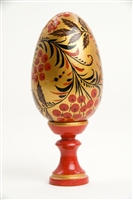Ukrainian Easter Eggs

A tradition dating back thousands of years, Ukrainian Easter eggs, or pysanky, is a beloved art that is still widely practiced today. To create their colorful eggs, artists employ a method of batik by using wax to draw patterns and designs. Dye is applied to the wax covered eggs in various stages that eventually reveal a final multi-colored design. This extraordinary art form is world-famous and even predates Christianity. In this article we'll explore this artistic tradition that has become synonymous with Easter celebrations.
In terms of the original history, referring to pysanky as Easter eggs is a bit of a misnomer. In Ukraine, the art of egg-decorating goes dates back to ancient times. The earliest Ukrainian eggs were decorated with symbols from nature that were meant to honor the tribes peoples' chief deity, a sun god. Consequently, birds became a major design component as these were the creatures that flew nearest to heaven. Birds' eggs were seen as magical objects which is why they were used to create art in these early times.
Although the egg initially symbolized a rebirth of nature to the Ukrainians, it would eventually come to symbolize the rebirth of man once Christianity was embraced by the people by the year 988. Many of the old symbols merged with new Christian symbols to create a melding of the old and new worlds. Some of the old sun-worshipping symbols still survive today, but their meanings have been adapted to Christian thought and worship.
Traditionally, the art of pysanky was practiced during the last week of lent. Knowledge of the art and special family traditions were passed down from mother to daughter. Dye was made from natural objects like dried plants, vegetables, berries, or even tree bark. Walnuts were used to create black dye, for example. Later, chemical dyes could be purchased as they became available.
Pysanky eggs are objects of decoration and so are not to be consumed. Artisans work with raw eggs and employ a wax-resist method of decorating that is similar to batik. A pin or stylus is used to write or draw designs on the egg using hot wax. Some crafters prefer to use wooden or ceramic eggs as their medium as opposed to real eggs, but this goes against tradition. Once created, the eggs might be given as special gifts to family members or close friends. They were usually displayed in a prominent part of the house where they could be admired by guests.
Color and design are important components of the tradition demonstrating the symbolism of the various eggs. Generally, darkly colored eggs were given to the elderly while bright eggs were given to the young. Geometric forms play a major role in the designs of many eggs. For instance, the triangle is meant to reflect the holy trinity. Diamonds were drawn to convey a sense of knowledge, and spirals were meant to suggest the great mysteries of life. Other designs that are popularly featured on pysanky are lines, ribbons, crosses, trees, flowers, leaves, fruit, animals, and other elements from nature. It is also not uncommon to find manmade objects on the eggs like windmills, baskets, or windows.
Interestingly, colors also have various meanings in the world of pysanky. White is used to symbolize purity. Gold is used to convey wisdom. Blue often represents the sky as well as truth and good health. Purple is believed to represent faith and patience. Red represents life, love, and divine love. Green is used to represent spring, fertility, and hope. Pink is used to reflect contentment. Of course, there are many other colors used as well, but their various combinations on a single egg can convey a wide array of meaning for the crafter.
While pysanky is still a Ukrainian tradition that is also practiced in many other Eastern European countries like Romania, the art is practiced in many other parts of the world as well where people have come to treasure the beautiful and spiritual objects. To make Ukrainian Easter eggs, you'll need the following items: raw white eggs, beeswax, pencils, candles, egg dyes, and vinegar. There are many books and online sites that teach the necessary techniques used for pysanky.
Comments (1)